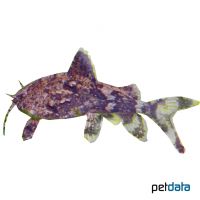Giant Moth Catfish (Erethistes pusillus)
| Giant Moth Catfish Erethistes pusillus | |
|---|---|
| Name | Giant Moth Catfish |
| Name Lat. | Erethistes pusillus |
| Family | Sisorid Catfishes |
| Family lat. | Sisoridae |
| Order | Catfishes |
| Order lat. | Siluriformes |
| Origin | South Asia |
| Habitat | Streams |
| Diet | Omnivore |
| pH | 6.0-7.0 |
| Behavior | Nocturnal, peaceful |
| Keeping | Group |
| Care Level | Moderate |
| Reproduction | Substrate spawner |
| Breeding | None reported |
| Life Span | 4-6 years |
| Protection | No |
| Metric Units | |
| Size | 4-5 cm |
| Temperature | 20-24 °C |
| Hardness | 2-12 °dH |
| Aquarium | ~ 50 l |
| US Units | |
| Size | 1.6-2" |
| Temperature | 68-75 °F |
| Hardness | 36-214 ppm |
| Aquarium | ~ 15 gal |
Distribution and habitat
The distribution area of the butterfly catfish is in India, Bangladesh and Myanmar. There they live in oxygen-rich, clear and slow-flowing streams and small rivers with soft muddy bottoms. During the day they usually stay hidden under roots or in stone caves.
Maintenance
They require an aquarium with dense marginal planting and many hiding places, such as stone caves (e.g. perforated rocks, catfish burrows) and roots. A soft sandy substrate covered with some beech or oak foliage, slightly dim light (e.g. floating plants), oxygen-rich water and a weak current is ideal
No ammonia, ammonium and nitrite should be detectable, the nitrate value should not exceed 100 mg/l. To ensure the water quality and oxygen content, a filter and heater adapted to the aquarium size is required, as well as lighting for the species-appropriate day-night rhythm of the animals.
Diet
The food supply consists mainly of live food, such as cyclops, daphnia, artemia, enchytraea and mosquito larvae, which are also eaten frozen without problems or a commercial frozen food mix for catfish. In addition, they need regular vegetable food, such as algae leaves. Sometimes sinking dry food for catfish with high vegetable content (spirulina, kelp) is also accepted, but should not be the main component of the diet
A regular and varied diet promotes health and prevents deficiency symptoms. Only as much should be fed as is eaten in a few minutes.
Behaviour and compatibility
It is recommended to keep these calm, crepuscular fish in a group of at least 5. They are very peaceful and can be socialized well with other calm and small fish. Socialization with larger, bottom-dwelling fish is not recommended
Basically, only compatible fish species with similar demands on water condition and water temperature may be socialized.
Sex dimorphism
No external distinguishing characteristics are known. Sexually mature females appear rounder and grow slightly larger than males.
Reproduction and breeding
There are no known reports of successful breeding in the aquarium.
Important
Erethistes pusillus are often confused with the similar Hara hara. During the day they usually stay hidden between plants and in rock crevices, while at dusk they move through the aquarium like schooling fish. Special attention should be paid to good water quality (high oxygen content) and a weekly partial water change is recommended.
When they are introduced into the aquarium, they often let themselves sink motionless to the bottom. When catching them, use nets with as fine a mesh as possible so that the very thin pectoral fins cannot get caught.
The well-being of the fish should be checked regularly. Temperature should be checked daily, pH, hardness and nitrate levels at least every 14 days. Regular partial water changes are recommended, even if the contaminant level has not yet reached the upper limit. Sudden changes in water quality should be avoided. Newly introduced fish must be accustomed slowly to the water in the aquarium
Further literature can be found in your pet store.
References
Text: Werner Winter; Image: petdata
Source: BMELV (1998): Tierschutzgutachten - Haltung von Zierfischen (Süßwasser); ENGELMANN (2005): Zootierhaltung - Tiere in menschlicher Obhut: Fische, Verlag Harri Deutsch; BAENSCH & RIEHL (1997): Aquarien Atlas Bd. 4, Mergus Verlag
- Gemäß § 21 Abs. 5 Tierschutzgesetz idgF
